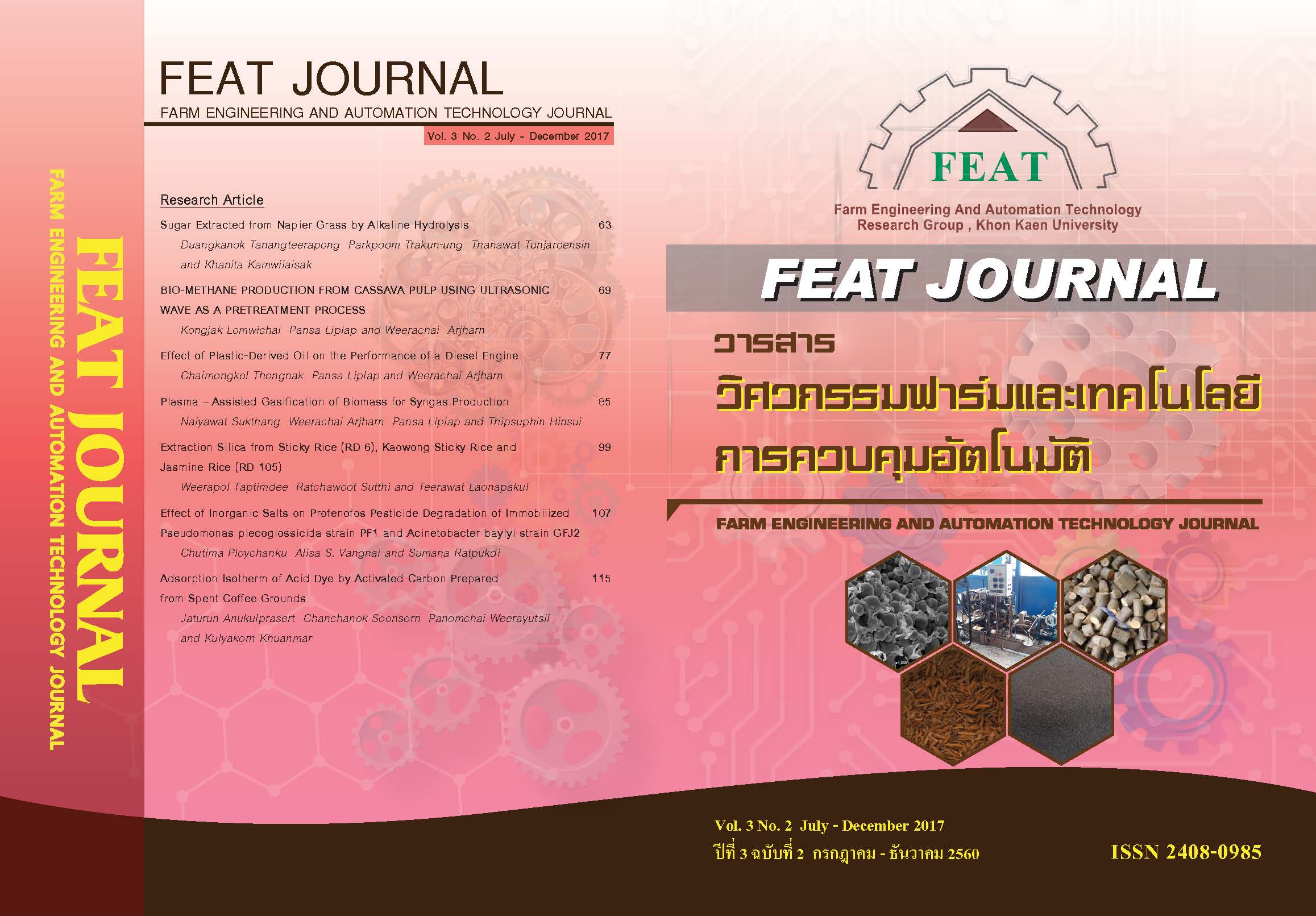การแยกซิลิกาจากองค์ประกอบที่ได้จากการเผาแกลบข้าว ข้าวเหนียว (กข 6) ข้าวเหนียวเขาวง และข้าวหอมมะลิ (กข 105)
Main Article Content
บทคัดย่อ
งานวิจัยนี้เป็นการศึกษาความแตกต่างของซิลิกาที่ได้จากเถ้าแกลบของ 3 พันธุ์ข้าว ได้แก่ ข้าวเหนียว (กข 6) ข้าวเหนียวเขาวง และข้าวหอมมะลิ (กข 105) ด้วยเทคนิคที่ไม่ผ่านการรีฟลักซ์และผ่านการรีฟลักซ์ จากนั้นนำไปผ่านกระบวนการทางความร้อนที่อุณหภูมิ 650°C เป็นระยะเวลา 1, 3, 5 และ 7 ชั่วโมง พบว่า เถ้าแกลบ ข้าวเหนียว (กข 6) ที่ผ่านกระบวนการทางความร้อนเป็นระยะเวลา 7 ชั่วโมง ที่ไม่ผ่านการรีฟลักซ์ และผ่านการรีฟลักซ์ จะให้ปริมาณซิลิกามากที่สุดที่ 93.249 wt% และ 99.086 wt% ตามลำดับ จากนั้นเถ้าแกลบดังกล่าวจะถูกนำไปวิเคราะห์โครงสร้างจุลภาคด้วย SEM วิเคราะห์หาชนิดและปริมาณของสารประกอบโดยเทคนิค XRF และวิเคราะห์โครงสร้างผลึกโดยเทคนิค XRD
Article Details
วารสารวิศวกรรมฟาร์มและเทคโนโลยีควบคุมอัตโนมัติ (FEAT Journal) มีกําหนดออกเป็นราย 6 เดือน คือ มกราคม - มิถุนายน และกรกฎาคม - ธันวาคม ของทุกปี จัดพิมพ์โดยกลุ่มวิจัยวิศวกรรมฟาร์มและเทคโนโลยีควบคุมอัตโนมัติ คณะวิศวกรรมศาสตร์มหาวิทยาลัยขอนแก่น เพื่อเป็นการส่งเสริมและเผยแพร่ความรู้ ผลงานทางวิชาการ งานวิจัยทางด้านวิศวกรรมศาสตร์และเทคโนโลยีพร้อมทั้งยังจัดส่ง เผยแพร่ตามสถาบันการศึกษาต่างๆ ในประเทศด้วย บทความที่ตีพิมพ์ลงในวารสาร FEAT ทุกบทความนั้นจะต้องผ่านความเห็นชอบจากผู้ทรงคุณวุฒิในสาขาที่เกี่ยวข้องและสงวนสิทธิ์ ตาม พ.ร.บ. ลิขสิทธิ์ พ.ศ. 2535
References
[2] Amick JA. Purification of rice hulls as a source of solar grade silicon for solar cells. Journal of the Electrochemical Society. 1982 Apr 1;129(4):864-6.
[3] Chakraverty A, Mishra P, Banerjee HD. Investigation of combustion of raw and acid-leached rice husk for production of pure amorphous white silica. Journal of Materials Science. 1988 Jan 1;23(1):21-4.
[4] Martinelli JR, Bressiani AH. The Influence of Process Variables During Rice Hulls Pyrolysis on the Formation of SiC Whiskers. Cerâmica. 1989 Nov;35(238):162-4.
[5] Nutt SR. Microstructure and Growth Model for Rice‐Hull‐Derived SiC Whiskers. Journal of the American Ceramic Society. 1988 Mar 1;71(3):149-56.
[6] Andreoli M, Luca GT, Seo EM. Characteristics of rice husks for chlorination reaction. Materials Letters. 2000 Jul 31;44(5):294-8.
[7] I.J. Silva, A.B. Melo, J.B.L. Liborio, M.F. Souza 1998 in: Proc. 42nd Brazilian Ceramic Congress and 4th Iberoamericano de Ceramica, Vidrios y Refratarios, Poc ´ ¸os de Caldas, SP, Brazil.
[8] P.K. Mehta 1996, in: International Congress on High-Performance Concrete and Performance and Quality of Concrete Structure, Florianopolis, Brazil.
[9] Rice Department, Ministry of Agriculture and Cooperatives, Thailand (2016). URL: http://www.ricethailand.go.th/web, access on 22/09/2016.
[10] Kurama H, Kurama SK. The effect of chemical treatment on the production of active silica from rice husk. In18th international mining congress and exhibition of Turkey-IMCET 2003.
[11] Swatsitang E, Krochai M. Preparation and characterization of silicon from rice hulls. J. Met. Mater. Miner. 2009;19(2):91-4.

